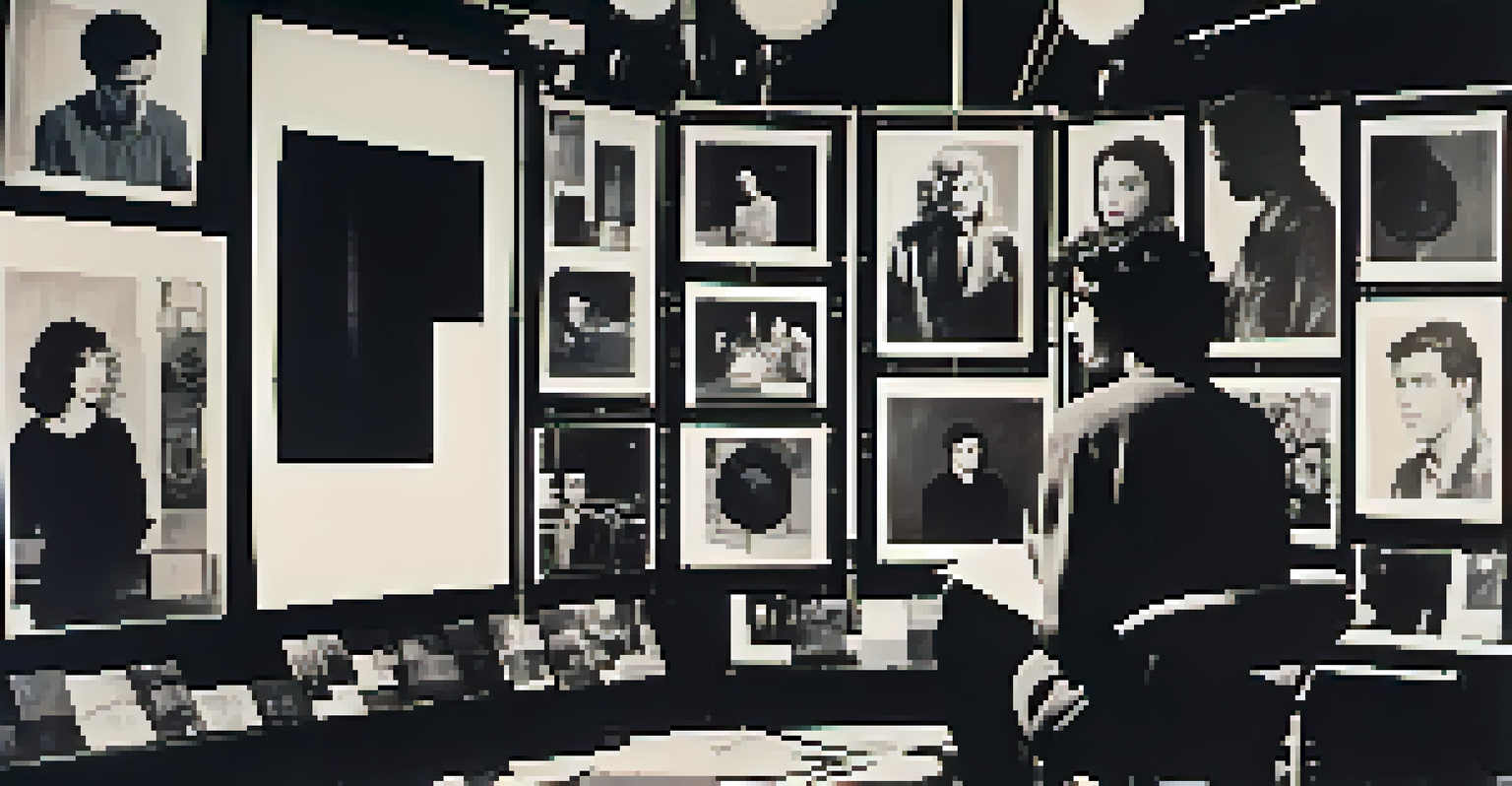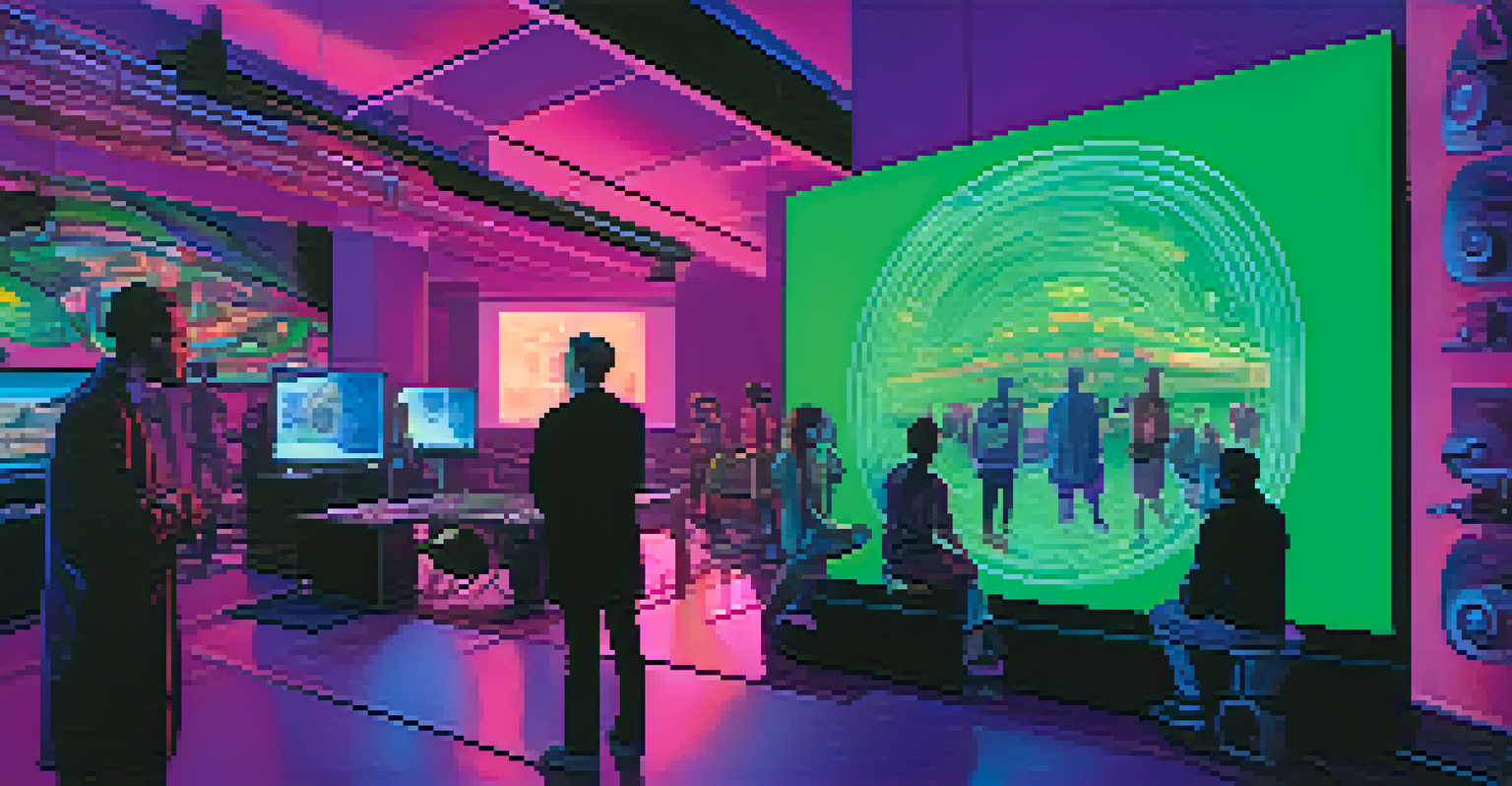The Role of Experimental Cinema in Shaping Film History

What is Experimental Cinema and Its Origins?
Experimental cinema refers to films that push the boundaries of traditional storytelling and filmmaking techniques. Originating in the early 20th century, it emerged from avant-garde movements that sought to challenge the norms established by commercial cinema. Filmmakers like Maya Deren and Stan Brakhage paved the way for this genre by focusing on visual experimentation and personal expression rather than conventional narrative structures.
Experimental film is a film that cannot be defined. It is a film that is self-reflective and aware of its own medium.
These films often emphasize artistic expression over commercial appeal, inviting viewers to engage with the medium in a more introspective way. The freedom to explore unconventional themes and styles allows filmmakers to reflect their inner thoughts and societal critiques, making experimental cinema a rich field for innovation. This genre's roots can be traced back to movements like Surrealism and Dadaism, where art was seen as a means of rebellion against established norms.
As we delve deeper into the evolution of film, it becomes clear that experimental cinema played a crucial role in shaping the landscape of modern filmmaking. By challenging traditional forms, it encouraged a generation of filmmakers to think outside the box, ultimately enriching the cinematic experience for audiences around the world.
Key Characteristics of Experimental Cinema
One of the defining characteristics of experimental cinema is its willingness to break the 'fourth wall' and engage the audience directly. Unlike mainstream films that often maintain a clear separation between the viewer and the story, experimental works invite viewers to question their own perceptions and interpretations. This interaction can manifest through fragmented narratives, unconventional editing techniques, or even direct address to the camera.

Another hallmark of experimental cinema is its exploration of visual aesthetics. Filmmakers often experiment with color, light, and sound to create unique sensory experiences. For example, the use of slow motion or fast cuts may evoke specific emotions or highlight thematic elements in unexpected ways. This focus on visual language allows filmmakers to communicate ideas that transcend spoken dialogue, making the viewing experience more immersive.
Experimental Cinema's Unique Nature
Experimental cinema challenges traditional storytelling and filmmaking techniques, focusing on personal expression and artistic innovation.
Moreover, experimental cinema frequently blurs the line between different forms of art, incorporating elements from theater, dance, and visual arts. This interdisciplinary approach not only enriches the film but also invites collaboration among artists from various backgrounds. As such, experimental cinema serves as a crucible for creative expression, fostering innovation that resonates across artistic disciplines.
Influential Figures in Experimental Cinema
Several filmmakers have made significant contributions to the world of experimental cinema, each leaving an indelible mark on film history. One of the most notable figures is Maya Deren, whose films like 'Meshes of the Afternoon' explore dreamlike narratives and psychological themes. Deren's work exemplifies the potential of experimental cinema to delve into the subconscious, inviting viewers to interpret her films on a deeply personal level.
The cinema is not a slice of life, but a piece of cake.
Stan Brakhage is another key figure, known for his unique approach to visual storytelling. His film 'Dog Star Man' is a prime example, combining abstract imagery with a visceral exploration of human experience. Brakhage's emphasis on the materiality of film—such as scratching and painting directly onto the film stock—demonstrates how experimental cinema can challenge traditional notions of what film can be.
These filmmakers, along with others like Kenneth Anger and Andy Warhol, have inspired countless artists and filmmakers to push the envelope of cinematic expression. Their innovative techniques and bold storytelling have not only influenced experimental cinema but have also seeped into mainstream filmmaking, proving that the spirit of experimentation is vital to the evolution of film as an art form.
The Relationship Between Experimental and Mainstream Cinema
While experimental cinema often exists in a realm separate from mainstream filmmaking, the two are deeply interconnected. Many techniques and narrative styles that originated in experimental films have been adopted by mainstream filmmakers to enhance their storytelling. For instance, the use of non-linear narratives and fragmented timelines, popularized by experimental cinema, have become staples in contemporary films, showcasing the influence of this genre.
Moreover, the success of certain experimental films has led to increased acceptance and appreciation of unconventional storytelling in the broader cinematic landscape. Films like 'Eraserhead' by David Lynch and 'The Blair Witch Project' demonstrate how experimental techniques can captivate mainstream audiences, proving that there is a hunger for innovative narratives.
Influence on Mainstream Filmmaking
Many techniques from experimental cinema, such as non-linear narratives, have been adopted by mainstream filmmakers, showcasing a dynamic exchange of ideas.
This relationship fosters a dynamic exchange of ideas, where mainstream cinema can take risks inspired by experimental works, while experimental filmmakers gain visibility and recognition. As both genres continue to evolve, it is evident that the dialogue between them enriches the film industry, encouraging creativity and pushing the boundaries of what cinema can achieve.
Cultural and Political Contexts in Experimental Cinema
Experimental cinema often serves as a reflection of the cultural and political landscapes in which it is created. During periods of social upheaval or political change, filmmakers have utilized experimental techniques to critique societal norms and challenge the status quo. For instance, the Dada movement emerged as a response to the horrors of World War I, using absurdity and shock to convey disillusionment with traditional values.
Additionally, many experimental films address issues of identity, race, and gender, providing a platform for marginalized voices. Filmmakers like Barbara Hammer and Isaac Julien explore themes of sexuality and race through innovative storytelling, pushing for broader representation in the film industry. This focus on underrepresented narratives not only enriches the genre but also sparks crucial conversations about societal issues.
In this way, experimental cinema becomes a powerful tool for social commentary, enabling filmmakers to engage with pressing issues in a thought-provoking manner. By challenging viewers to confront difficult topics, experimental films can inspire reflection and promote dialogue, ultimately influencing cultural discourse.
The Evolution of Technology and Experimental Cinema
The advancement of technology has profoundly impacted the landscape of experimental cinema, enabling filmmakers to explore new creative possibilities. With the advent of digital filmmaking and editing software, artists can experiment with visual effects and sound design in ways that were previously unimaginable. This technological evolution has democratized filmmaking, making it accessible to a broader range of creators, from hobbyists to professionals.
For instance, the rise of online platforms has allowed experimental filmmakers to share their work with global audiences, bypassing traditional distribution channels. This shift has led to a more diverse array of voices contributing to the genre, enriching its narrative and stylistic diversity. Filmmakers can now easily collaborate and experiment across geographical boundaries, fostering a vibrant, interconnected community.
Cultural Commentary Through Film
Experimental cinema often reflects cultural and political contexts, providing a platform for marginalized voices and sparking important societal conversations.
As technology continues to evolve, so too will the possibilities for experimental cinema. From virtual reality experiences to interactive narratives, the future holds exciting prospects for filmmakers willing to push the boundaries of the medium. This ongoing evolution ensures that experimental cinema remains a vital and dynamic part of the film industry, continuously inspiring new generations of creators.
The Future of Experimental Cinema in Film History
As we look to the future, the role of experimental cinema in shaping film history is more relevant than ever. With increasing emphasis on diversity and inclusion, experimental filmmakers have the opportunity to explore untold stories and challenge established narratives. This shift can lead to a richer cinematic landscape, one that reflects a wider array of human experiences and perspectives.
Moreover, as audiences become more sophisticated and open to unconventional storytelling, the demand for innovative cinema will likely grow. Filmmakers who embrace experimentation will continue to influence mainstream cinema, pushing for more authentic and varied storytelling methods. This symbiotic relationship ensures that experimental cinema will remain a crucial component of the film industry's evolution.

Ultimately, the legacy of experimental cinema is one of innovation, creativity, and resistance. By encouraging filmmakers to challenge conventions and explore new horizons, this genre will continue to inspire future generations, shaping the way we understand and experience film for years to come.